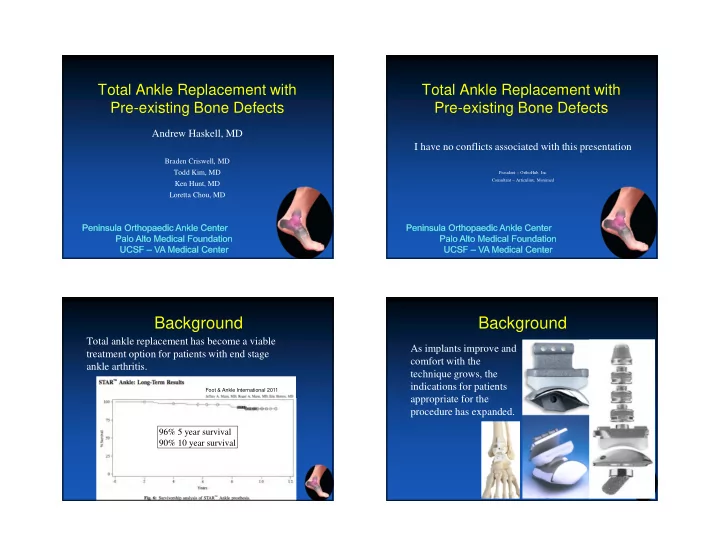

5/8/2014 Total Ankle Replacement with Total Ankle Replacement with Pre-existing Bone Defects Pre-existing Bone Defects Andrew Haskell, MD I have no conflicts associated with this presentation Braden Criswell, MD Todd Kim, MD President – OrthoHub, Inc Consultant – Articulinx, Moximed Ken Hunt, MD Loretta Chou, MD Background Background Total ankle replacement has become a viable As implants improve and treatment option for patients with end stage comfort with the ankle arthritis. technique grows, the indications for patients Foot & Ankle International 2011 appropriate for the procedure has expanded. 96% 5 year survival 90% 10 year survival 1
5/8/2014 Background Goals One area that has not • Describes the prevalence of bone defects in a received attention is the cohort of patients undergoing total ankle management of preexisting replacement tibial and talar bone defects • Compare complication rates of those during primary total ankle with and without bone defects replacement. • Hypothesis: The presence of bone defects at the time of total ankle surgery will effect the rate of early complications. Methods Demographics Demographics Age 67 ± 10 • Retrospective study approved by PAMF IRB BMI 30.25 ± 4.04 • Consecutive series of 124 patients undergoing DM 14/124 11% total ankle replacement between 2007 and Smoking 2/124 2% 2013 Post-traumatic/instability 87/124 70% Revision 11/124 8% • Demographic and case specific data were collected from medical records and PACS system • Chi-square 2
5/8/2014 Overall Complications Bone Loss over the first year • Low bar set to define bone loss • Location Complication Type Any Complications • Tibia, Talus Wound 15/124 12% No 92/124 74% Other 8/124 7% Yes 32/124 26% Fractur 6/124 5% • Classification e • Contained vs Uncontained Osteolysis 3/124 2% Wound problems Contained Uncontained Other • Surgical Accommodation No Complication Fracture Complication • observe or cut out, bone graft, change implant Osteolysis Bone Loss Bone Loss - Tibia Any Bone Loss Tibia Containment No Bone Loss 39/115 34% Bone Loss Location Contained 34/67 51% Bone Loss 76/115 66% Tibia 67/76 88% Uncontained 33/67 49% Talus 37/76 49% 80 70 Contained 60 No Bone Loss Uncontained 50 66% Bone Loss 40 30 20 10 Uncontained Contained 0 Tibia Talus Observe 25/33 76% Observe 22/34 65% Change 8/33 24% Bone Graft 12/34 35% Surgical Strategies Implant observe observe bone graft change implant 3
5/8/2014 Tibial bone loss - contained Tibial bone loss - uncontained Rim-fit implant and bone graft defect Bypass defect with stem Talus bone loss - contained Bone Loss – Talus Rim-fit implant and bone graft defect Talus Containment Contained 22/37 59% Uncontained 15/37 41% Contained Uncontained Uncontained Contained Observe 9/15 60% Observe 16/22 73% Change 6/15 40% Bone Graft 6/22 27% Surgical Strategies Implant observe observe bone graft change implant 4
5/8/2014 Is there an association of Bone Loss and No Association of Bone Loss Talus bone loss - uncontained and Complications Complications? Consider Reconstruction No Complication Complication Complication Rate No Bone Loss 26 13 33% p=0.27 Bone Loss 58 18 24% No Association of Bone Grafting and Complications No Complication Complication Complication Rate No Bone Grafting 81 29 26% p=0.69 Bone Grafting 11 3 21% Discussion/Summary Thank You • Unable to demonstrate an association between bone loss and early complications • Primary Total Ankle? • We offer a new classification system to organize future research in this area and outline strategies for maintaining implant stability in this challenging population • Possibly biases • surgeon experience • short follow-up • non-randomized 5
Recommend
More recommend